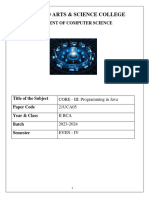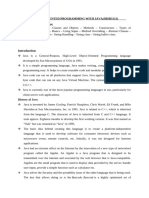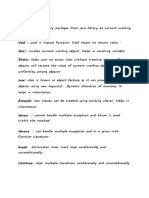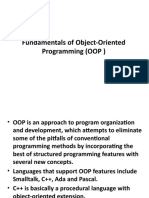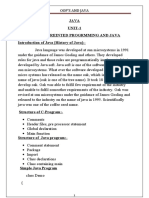0 ratings0% found this document useful (0 votes)
6 viewsOOP Java Unit1 Unit2 Detailed Notes
The document provides detailed notes on Object-Oriented Programming (OOP) using Java, covering key concepts such as encapsulation, inheritance, polymorphism, and abstraction. It also outlines the Java compilation process, security mechanisms in the JVM, and fundamental Java features including data types, control flow statements, and exception handling. Additionally, it discusses the Collection API and the use of iterators for traversing data structures.
Uploaded by
RGSCopyright
© © All Rights Reserved
Available Formats
Download as PDF, TXT or read online on Scribd
0 ratings0% found this document useful (0 votes)
6 viewsOOP Java Unit1 Unit2 Detailed Notes
The document provides detailed notes on Object-Oriented Programming (OOP) using Java, covering key concepts such as encapsulation, inheritance, polymorphism, and abstraction. It also outlines the Java compilation process, security mechanisms in the JVM, and fundamental Java features including data types, control flow statements, and exception handling. Additionally, it discusses the Collection API and the use of iterators for traversing data structures.
Uploaded by
RGSCopyright
© © All Rights Reserved
Available Formats
Download as PDF, TXT or read online on Scribd
You are on page 1/ 2
Object-Oriented Programming (OOP) Using Java - Detailed Notes
Unit 1: Introduction to Object-Oriented Programming
1. Object-Oriented Programming (OOP) Overview:
- OOP is a programming paradigm based on real-world objects.
- It combines data (attributes) and behavior (methods).
2. Procedural vs. Object-Oriented Programming:
- Procedural: Follows a sequence of steps (e.g., C).
- OOP: Models real-world entities using classes and objects (e.g., Java).
3. Core OOP Concepts:
- Encapsulation: Hiding data using private access.
- Inheritance: Reusing parent class properties in child classes.
- Polymorphism: One interface, multiple implementations.
- Abstraction: Hiding implementation details.
4. Java Compilation & Execution Process:
- Source Code (.java) -> Bytecode (.class) -> Execution via JVM.
5. Security in JVM:
- Java provides memory protection, bytecode verification, and access control.
6. Sandbox Model:
- A security mechanism that restricts untrusted code execution.
Unit 2: Java Fundamentals
1. Data Types and Literals:
- Java supports primitive (int, float, boolean) and reference (String, Arrays) data types.
2. Wrapper Classes:
- Convert primitive types to objects (Integer, Double).
3. Arrays in Java:
- Used to store multiple values of the same type.
- Example:
int[] numbers = {1, 2, 3};
4. Operators in Java:
- Arithmetic: +, -, *, /
- Logical: &&, ||, !
5. Control Flow Statements:
- Conditional: if-else, switch
- Loops: for, while, do-while
6. Classes and Objects:
- A class is a blueprint; an object is an instance.
- Example:
class Car { String brand; }
7. Exception Handling:
- try-catch block handles runtime errors.
8. Collection API:
- Used for data structures (ArrayList, HashMap).
9. Iterators:
- Used to traverse collections.
- Example:
Iterator<Integer> it = list.iterator();
You might also like
- Hourglass Workout Program by Luisagiuliet 276% (21)Hourglass Workout Program by Luisagiuliet 251 pages
- Read People Like A Book by Patrick King-Edited57% (82)Read People Like A Book by Patrick King-Edited12 pages
- Livingood, Blake - Livingood Daily Your 21-Day Guide To Experience Real Health77% (13)Livingood, Blake - Livingood Daily Your 21-Day Guide To Experience Real Health260 pages
- Donald Trump & Jeffrey Epstein Rape Lawsuit and Affidavits83% (1016)Donald Trump & Jeffrey Epstein Rape Lawsuit and Affidavits13 pages
- The 36 Questions That Lead To Love - The New York Times91% (35)The 36 Questions That Lead To Love - The New York Times3 pages
- The 36 Questions That Lead To Love - The New York Times95% (21)The 36 Questions That Lead To Love - The New York Times3 pages
- Jeffrey Epstein39s Little Black Book Unredacted PDF75% (12)Jeffrey Epstein39s Little Black Book Unredacted PDF95 pages
- 14 Easiest & Hardest Muscles To Build (Ranked With Solutions)100% (8)14 Easiest & Hardest Muscles To Build (Ranked With Solutions)27 pages
- The 4 Hour Workweek, Expanded and Updated by Timothy Ferriss - Excerpt23% (954)The 4 Hour Workweek, Expanded and Updated by Timothy Ferriss - Excerpt38 pages
- ICSE Class 10 Full Computer Theory NotesNo ratings yetICSE Class 10 Full Computer Theory Notes9 pages
- ICSE Class 10 Full Computer Theory NotesNo ratings yetICSE Class 10 Full Computer Theory Notes9 pages
- Unit 1 - Intro To OOP and Java FundamentalsNo ratings yetUnit 1 - Intro To OOP and Java Fundamentals11 pages
- Java Programming for Beginners – Comprehensive NotesNo ratings yetJava Programming for Beginners – Comprehensive Notes6 pages
- Object_Oriented_Programming_through_Java_Digital_Notes_Maruthi_PNo ratings yetObject_Oriented_Programming_through_Java_Digital_Notes_Maruthi_P136 pages
- Introduction To Java Programming - BCB2302No ratings yetIntroduction To Java Programming - BCB23026 pages
- Java UNIT-1 Object-Oreinted Progrmming and Java Introduction of Java (History of Java)No ratings yetJava UNIT-1 Object-Oreinted Progrmming and Java Introduction of Java (History of Java)13 pages
- Java Package Mastery: 100 Knock Series - Master Java in One Hour, 2024 EditionFrom EverandJava Package Mastery: 100 Knock Series - Master Java in One Hour, 2024 EditionNo ratings yet









































